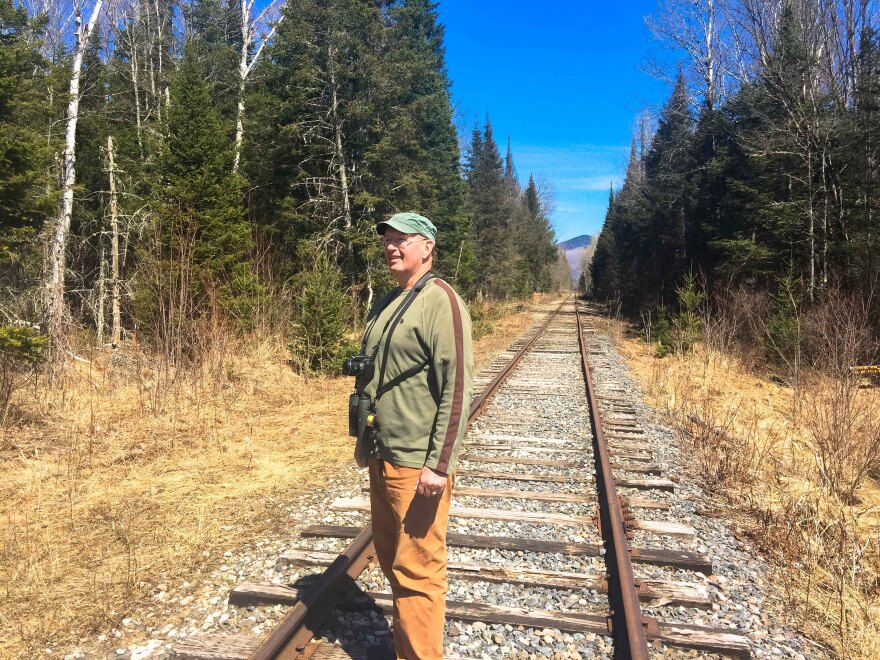At sunrise on May 9th birders from around the Granite State will converge on the Pondicherry National Wildlife Refuge in Jefferson for International Migratory Bird Day. Local naturalist and bird expert David Govatski will be on hand to help identify the nearly 100 species of birds arriving at the refuge, considered one of the top birding spots in the state. NHPR's Sean Hurley recently toured the area with Govatski and sends us this.
On one side of Airport Road, Piper Cubs and Cessnas fly in over Cherry Pond to land on the runway meadow of the Mount Washington Airport. On the other side, as David Govatski points out, it's brown thrashers and wigeons flying in.

"So this is Airport Marsh right here and it's one of the best places in the North Country to really get a good look at a lot of, not only water birds, but grassland birds, things like bobolinks will be here in another month."
After splashing down, two hooded mergansers begin to paddle toward the far shore of the marsh where a lone rusty blackbird flips old leaves looking for food. A moment after telling me the Ospreys should be here any day now, a large shadow crosses our path and we look up -
"That's an Osprey. And that is a good sighting. That's the first one I've seen. You know, really good birders, they can get a shadow flying over and they can tell exactly what kind of species it is. Just from the shadows."

Four to five million birds, Govatski says, are migrating now, coming north from as far away as Argentina. Some stop here to nest and raise their young, others move on to Canada.
"I see a pair of wigeons out there right now. They must've just flown in I didn't see them earlier. It's like a highway refueling stop to come here."
By profession, Govatski is a forester. Retired now, he's spent the last 25 years studying the birds, wildlife and trees of the Pondicherry Refuge. In 2010 with his friend Sam Stoddard, Govatski found the biggest black spruce in the nation. The 93 foot tall National Champion is just off the trail to Little Cherry Pond.
"We deposed that tree in Maine, they're probably not happy with us."

Govatski takes me down the mile and half Pondicherry Trail to Cherry Pond.
"We hear red breasted nuthatch going yank yank yank call. Oh, that's a ruffed grouse. This is a balsam poplar, it's really in the aspen family."
He goes on like this naming nearly everything we see or hear. Moose tracks, larches, blights, mosses, cinnamon roses. Winter wrens and ravens.
"Here's a rough grouse scat right here. I can tell the difference between rough grouse and spruce grouse by the scat."
This isn't a boast, he's just letting me know there's a difference.
"And I hear a song sparrow and there are some swamp sparrows here."

On the raised berm of Shore Path, we pass along the edge of the hundred acre pond. Though set at the lowest part of the valley, the land surrounding Cherry Pond is so flat for such a distance there's a wide open sense of vista.
"Look at these boulders! Look what the ice did and moved it here. I've had several geologist come out here and I don't tell them anything and I asked them what caused this? They didn't know."
What he means is the rounded ridge of earth encircling the pond. As you walk the trail you do so at height - five or six feet above the water on a rare geologic feature Govatski calls an ice push rampart.
"And what happens when water freezes, it expands and gets much bigger so it's like a bulldozer. Every year for 12,000 years it has pushed gravel and rocks and boulders up here to form this berm which goes almost the entire way around this pond."
Scattered throughout the refuge are seven benches along with a hundred foot boardwalk that leads out over the pond to the Tudor Richards viewing platform.

"We call them dalliance points. It's a technical term, where you can dillydally and you can dream."
On May 9th, the gathered birders will walk the ice push ramparts and daydream at the dalliance points and if they wonder about any of the hundred species of birds flying in, or want to know where the champion Black Spruce stands, or the name of any tree, or really anything they see or come upon, David Govatski will be there, happy to oblige.
"There's a couple of Canada Geese flying in. "





